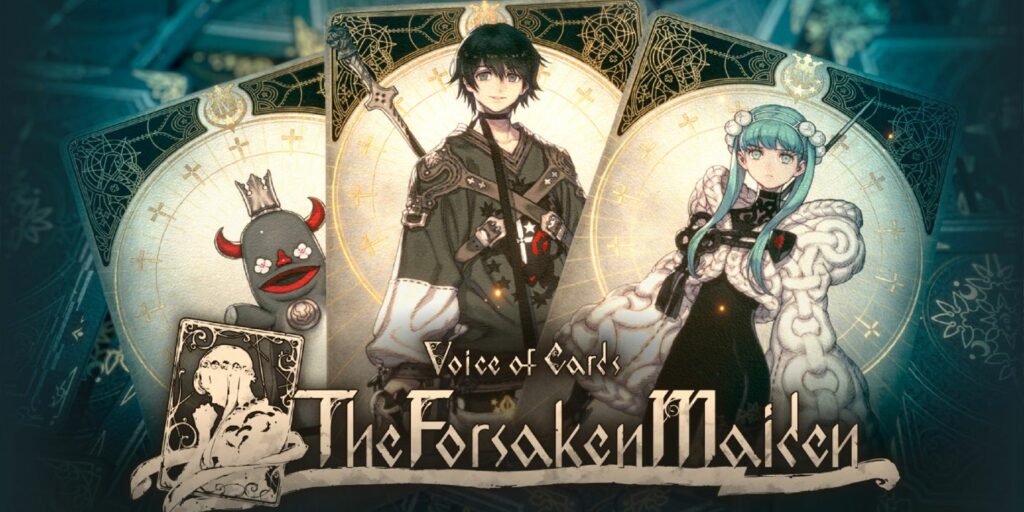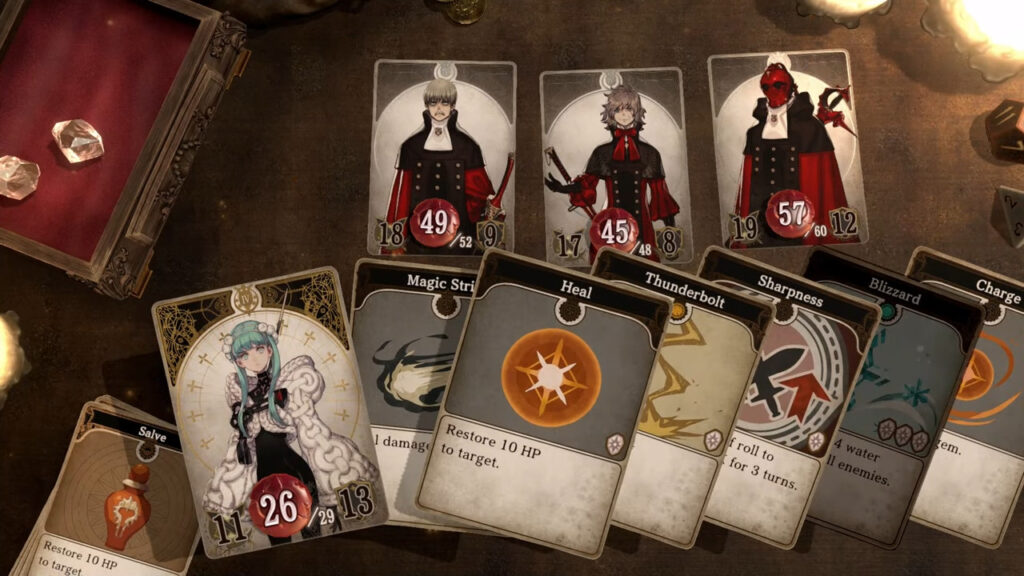
Developer: Alim
Publisher: Square Enix
Platform: Switch, PS4, PC
Tested on: Switch
Voice of Cards: The Forsaken Maiden – Review
It has only been four months since Yoko Taro delighted us with Voice of Cards: The Isle Dragon Roars, and we’re already invited back to the Voice of Cards universe with the second game in the series, Voice of Cards: The Forsaken Maiden. Judging from the trailer, it looks like we’re getting more of the same but given how much we loved the previous title, that’s not necessarily a bad thing. Can The Forsaken Maiden live up to her predecessor or could this new chapter in the series have used a little more time in the oven?
Story
The story presented here is probably the main draw for returning players, and we are happy to say that it is where The Forsaken Maiden truly shines and rises above its predecessor. Set in a more nautical part of the world, The Forsaken Maiden introduces us to a new pair of protagonists, level-headed navigator Barren and his companion Laty, a young girl who is unable to talk. Our two heroes live on an island in Omega Village. Unfortunately, according to a prophecy, this quaint little village is doomed to meet its demise unless the titular forsaken maiden performs a ritual there. As it turns out, Laty happens to be the maiden in question but because she doesn’t have the ability to speak, she is unable to perform the ritual. Laty’s plight puts our heroes on a journey to visit the maidens of the nearby islands, as they attempt to find a way to save Omega Village and discover the truth about Laty’s past.
Graphics
Featuring a new set of characters and a different part of the world, The Forsaken Maiden feels alien and familiar at the same time, as many of the assets from the first game are reused. Our protagonists feature new designs of course, but the overworld map, combat screen, and many of the enemies are represented using the same cards we’ve seen in The Isle Dragon Roars. Under other circumstances, we’d say that reusing this many assets feels lazy but it makes sense with Voice of Cards, as it actually helps with evoking the feeling that this is a tabletop RPG. You’re simply playing a different campaign with the same ruleset after all and, like anyone that has ever played Dungeons & Dragons or a similar game can attest, reusing components to craft new stories is a very common occurrence. The visual style employed in Voice of Cards remains as lovely as it ever was, so there are no complaints from us here.
Sound
If you’ve played The Isle Dragon Roars, you might notice that the narrator from that game isn’t the same one as the one that accompanies you in The Forsaken Maiden. Given that the narrator also plays the part of the game master, this ties into our earlier observation about The Forsaken Maiden feeling like a different campaign within the same tabletop RPG system, as this equals to sitting at the table with a different Game Master. This time around, the narrator, voiced by Mark Atherlay, sounds younger and he puts more energy into his performance, compared to the more serious performance of Todd Haberkorn from the previous game. Atherlay breaks the fourth wall more often too, directly speaking to the player, creating another level of immersion. Sound effects are the same as those from the previous title, of course, although the music isn’t. It’s in the same style, but the tracks composed by Keiichi Okabe are new as far as we could tell. These atmospheric tunes contribute to the mysterious, yet laid-back nature of the adventure you’re playing through.
Gameplay
If we were to simply copy and paste the gameplay section of our review of The Isle Dragon Roars, we’d be covering about 90% of what The Forsaken Maiden has to offer. Both games use the exact same engine and gameplay premise. It’s classic JRPG gameplay featuring exploration, random encounters and turn-based battles, with Voice of Cards’ unique selling point being that everything is presented as if it’s a tabletop RPG, with everything from the world map all the way to our protagonists being represented with cards. If you’ve played through the first game (or even the free demo) you already know exactly what to expect, but that’s not necessarily a bad thing because both entries in the Voice of Cards series so far are utterly charming and delightful little games.
The turn-based combat system still feels fresh. On each turn, characters generate gems, which can subsequently be spent on more powerful attacks. The key in winning battles lies in deciding when to use gems and when to use standard attacks. The introduction of a single new gameplay mechanic here feels like an attempt to give The Forsaken Maiden its own identity, but it’s not enough to make it stand apart from its predecessor, at least from a gameplay perspective. Said mechanic comes in the form of Link Skills, which allows your party members to team up to perform an attack rather than acting as individuals. It’s a neat little addition that can make all the difference when you use it at the right moment, but it’s also very situational and we found that we couldn’t make good use of it as much as we wanted to.
The Forsaken Maiden doesn’t really avoid the few pitfalls that plagued The Isle Dragon Roars: story choices still feel like they only have a minor impact and JRPG veterans might find that the game is a little light on content compared to Square Enix’s other offerings. However, any downsides to the game are outweighed by the good. With The Forsaken Maiden, Yoko Taro proves that there is plenty of life in the Voice of Cards engine, and we can’t wait to see what journey the franchise takes us on next. This is a delightful little RPG, with a fairly simplistic approach to its gameplay, but it also feels incredibly polished. Every aspect of The Forsaken Maiden feels carefully and lovingly crafted, from the fantastic worldbuilding to the combat system. If you weren’t a fan of the first game, then The Forsaken Maiden isn’t going to convince you, but if you enjoyed The Isle Dragon Roars, then you’re going to love returning to this universe.
Conclusion
With The Isle Dragon Roars still very fresh in our minds, The Forsaken Maiden seems more like an additional chapter rather than a game in its own right. There isn’t enough new content here to make this second entry in the Voice of Cards series feel entirely fresh, but given that we were far from burned out from the first game, we were more than happy to return to the series. If you enjoyed the first game in the series, then picking this one up is a no-brainer, but as an entry point into the series, you’re actually best off giving the free prequel demo to the series a spin instead. While it doesn’t tie into The Forsaken Maiden storywise, it’s a great way to familiarise yourself with the gameplay to decide if the franchise is your cup of tea.
Voice of Cards: The Forsaken Maiden - Review,








No Comments